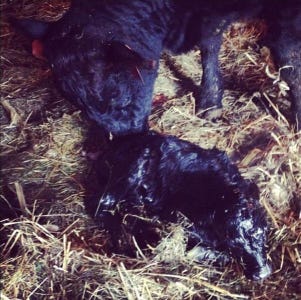5 tips to do now to prepare for breeding success this summer
March 2, 2016

Did you know that the decisions you make and the management strategies you follow during calving season will ultimately determine your success for conception rates and reproductive health in the upcoming breeding season?
Here are five tips from Les Anderson, University of Kentucky Extension professor, for preparing for a successful breeding season now, as featured in the Ohio State University Extension Beef newsletter.
 1. Evaluate and manage body condition scores (BCS)
1. Evaluate and manage body condition scores (BCS)
“Reproductive management begins with evaluation and management of BCS,” writes Anderson. “Rebreeding performance of cows is greatly influenced by BCS at calving. Cows that are thin at calving take longer to resume estrous cycles and therefore are delayed in their ability to rebreed. Research has clearly demonstrated that as precalving BCS decreases, the number of days from one calving to the next (calving interval) increases in beef cows.”
Anderson adds, “Management of BCS after calving also impacts rebreeding efficiency. Maintenance requirements for energy and protein increase 25-30% for most beef cows after calving. Ranchers need to plan their supplementation to match or exceed this increased nutrient requirement. Rebreeding efficiency is enhanced in cows that calved thin if their energy intake is increased. Although the best management plan is to calve cows in a BCS of 5+, increasing the energy to cows that are thin at calving can boost reproductive performance.”
2. Respond to calving problems early
“Dystocia (calving problems) can severely delay the onset of estrus after calving,” warns Anderson. “Research shows that for every hour a female is in stage two active labor, there is a four day delay in the resumption of estrous cycles after calving. Early intervention helps; 16% more cows conceived when cows were assisted within 90 minutes of the start of calving. The best method is to reduce the incidence of dystocia via selection but early calving assistance will increase the opportunity of cows to rebreed.”
3. Don’t forget breeding soundness exams for the herd bulls
Anderson says, “One often overlooked management tool that can improve reproductive performance is breeding soundness exams in bulls. Ranchers need to think of breeding soundness exams as breeding season insurance. These exams are a low-cost method of insuring that your bull is not infertile. Bulls should be examined for breeding soundness about 30 days before they are turned out.”
4. Vaccinate against reproductive diseases
Several diseases such as lepto, BVD, vibrio and trich are associated with reproductive losses. These losses can be avoided if cattlemen vaccinate their herds against these reproductive diseases.
Anderson writes, “The main problem is that most reproductive loss due to disease is subtle and ranchers don’t notice the loss unless they have a massive failure. Most cattlemen are not aware of their losses due to abortion. Ranchers need to work with their local veterinarian to develop an annual vaccination plan to enhance reproductive success.”
5. Offer extra care to first-calf heifers and late-calving cows
“Young cows and late-calving cows have one characteristic in common that will greatly impact their reproductive success; anestrus,” says Anderson. “After each calving, cows undergo a period of time when they do not come into estrus. This anestrus period can be as short as 17 days but can also last as long as 150 days depending upon a number of factors. Cattlemen can reduce the anestrous period by fenceline exposure to a mature bull or by treating the cows with progesterone for seven days prior to bull exposure. Pregnancy rates will actually be increased in these females because inducing estrus will increase the number of opportunities these cows have to conceive in the breeding season.”
Keep these tips in mind now during calving season in order to have a more successful breeding season this summer.
The opinions of Amanda Radke are not necessarily those of beefmagazine.com or Penton Agriculture.
You might also like:
Breathtaking photos of winter on the ranch
70 photos showcase generations working together on ranch
2016 market outlook: Here's what to expect
You May Also Like



